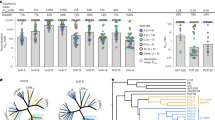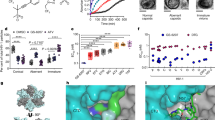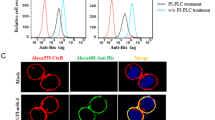Abstract
Combination antiretroviral therapy has transformed HIV-1 infection, once a fatal illness, into a manageable chronic condition. Drug resistance, severe side effects and treatment noncompliance bring challenges to combination antiretroviral therapy implementation in clinical settings and indicate the need for additional molecular targets. Here, we have identified several small-molecule fusion inhibitors, guided by a neutralizing antibody, against an extensively studied vaccine target—the membrane proximal external region (MPER) of the HIV-1 envelope spike. These compounds specifically inhibit the HIV-1 envelope-mediated membrane fusion by blocking CD4-induced conformational changes. An NMR structure of one compound complexed with a trimeric MPER construct reveals that the compound partially inserts into a hydrophobic pocket formed exclusively by the MPER residues, thereby stabilizing its prefusion conformation. These results suggest that the MPER is a potential therapeutic target for developing fusion inhibitors and that strategies employing an antibody-guided search for novel therapeutics may be applied to other human diseases.

This is a preview of subscription content, access via your institution
Access options
Access Nature and 54 other Nature Portfolio journals
Get Nature+, our best-value online-access subscription
$29.99 / 30 days
cancel any time
Subscribe to this journal
Receive 12 print issues and online access
$259.00 per year
only $21.58 per issue
Buy this article
- Purchase on Springer Link
- Instant access to full article PDF
Prices may be subject to local taxes which are calculated during checkout




Similar content being viewed by others
Data availability
The atomic structure coordinates and NMR data are deposited in the Protein Data Bank under the accession number 6V4T. All other related data generated during and/or analyzed during the current study are available from the corresponding author on reasonable request.
References
Hammer, S. M. et al. A controlled trial of two nucleoside analogues plus indinavir in persons with human immunodeficiency virus infection and CD4 cell counts of 200 per cubic millimeter or less. AIDS Clinical Trials Group 320 Study Team. N. Engl. J. Med. 337, 725–733 (1997).
Gulick, R. M. et al. Treatment with indinavir, zidovudine, and lamivudine in adults with human immunodeficiency virus infection and prior antiretroviral therapy. N. Engl. J. Med. 337, 734–739 (1997).
Palella, F. J. Jr. et al. Declining morbidity and mortality among patients with advanced human immunodeficiency virus infection. HIV Outpatient Study Investigators. N. Engl. J. Med. 338, 853–860 (1998).
Grant, M., Samuel, R., Bettiker, R. L. & Suh, B. Antiretroviral therapy 2010 update: current practices and controversies. Arch. Pharm. Res. 34, 1045–1053 (2011).
Thompson, M. A. et al. Antiretroviral treatment of adult HIV infection: 2012 recommendations of the International Antiviral Society-USA panel. JAMA 308, 387–402 (2012).
Kilby, J. M. & Eron, J. J. Novel therapies based on mechanisms of HIV-1 cell entry. N. Engl. J. Med. 348, 2228–2238 (2003).
Robertson, D. U. S. FDA approves new class of HIV therapeutics. Nat. Biotechnol. 21, 470–471 (2003).
Poveda, E. et al. Dynamics of enfuvirtide resistance in HIV-infected patients during and after long-term enfuvirtide salvage therapy. J. Clin. Virol. 34, 295–301 (2005).
Poveda, E. et al. Evolution of genotypic and phenotypic resistance to enfuvirtide in HIV-infected patients experiencing prolonged virologic failure. J. Med. Virol. 74, 21–28 (2004).
Sista, P. R. et al. Characterization of determinants of genotypic and phenotypic resistance to enfuvirtide in baseline and on-treatment HIV-1 isolates. AIDS 18, 1787–1794 (2004).
He, Y. et al. Design and evaluation of sifuvirtide, a novel HIV-1 fusion inhibitor. J. Biol. Chem. 283, 11126–11134 (2008).
Pan, C., Cai, L., Lu, H., Qi, Z. & Jiang, S. Combinations of the first and next generations of human immunodeficiency virus (HIV) fusion inhibitors exhibit a highly potent synergistic effect against enfuvirtide-sensitive and -resistant HIV type 1 strains. J. Virol. 83, 7862–7872 (2009).
Xie, D. et al. An albumin-conjugated peptide exhibits potent anti-HIV activity and long in vivo half-life. Antimicrob. Agents Chemother. 54, 191–196 (2010).
Santos, J. R. et al. Efficacy and safety of switching from enfuvirtide to raltegravir in patients with virological suppression. HIV Clin. Trials 10, 432–438 (2009).
Chen, B. Molecular mechanism of HIV-1 entry. Trends Microbiol. 27, 878–891 (2019).
Weissenhorn, W., Dessen, A., Harrison, S. C., Skehel, J. J. & Wiley, D. C. Atomic structure of the ectodomain from HIV-1 gp41. Nature 387, 426–430 (1997).
Chan, D. C., Fass, D., Berger, J. M. & Kim, P. S. Core structure of gp41 from the HIV envelope glycoprotein. Cell 89, 263–273 (1997).
Julien, J. P. et al. Crystal structure of a soluble cleaved HIV-1 envelope trimer. Science 342, 1477–1483 (2013).
Lyumkis, D. et al. Cryo-EM structure of a fully glycosylated soluble cleaved HIV-1 envelope trimer. Science 342, 1484–1490 (2013).
Pancera, M. et al. Structure and immune recognition of trimeric pre-fusion HIV-1 Env. Nature 514, 455–461 (2014).
Chan, D. C. & Kim, P. S. HIV entry and its inhibition. Cell 93, 681–684 (1998).
Frey, G. et al. A fusion-intermediate state of HIV-1 gp41 targeted by broadly neutralizing antibodies. Proc. Natl Acad. Sci. USA 105, 3739–3744 (2008).
Chen, J. et al. Mechanism of HIV-1 neutralization by antibodies targeting a membrane-proximal region of gp41. J. Virol. 88, 1249–1258 (2014).
Montero, M., van Houten, N. E., Wang, X. & Scott, J. K. The membrane-proximal external region of the human immunodeficiency virus type 1 envelope: dominant site of antibody neutralization and target for vaccine design. Microbiol. Mol. Biol. Rev. 72, 54–84 (2008).
Muster, T. et al. A conserved neutralizing epitope on gp41 of human immunodeficiency virus type 1. J. Virol. 67, 6642–6647 (1993).
Stiegler, G. et al. A potent cross-clade neutralizing human monoclonal antibody against a novel epitope on gp41 of human immunodeficiency virus type 1. AIDS Res. Hum. Retroviruses 17, 1757–1765 (2001).
Huang, J. et al. Broad and potent neutralization of HIV-1 by a gp41-specific human antibody. Nature 491, 406–412 (2012).
Frey, G. et al. Distinct conformational states of HIV-1 gp41 are recognized by neutralizing and non-neutralizing antibodies. Nat. Struct. Mol. Biol. 17, 1486–1491 (2010).
Zhang, J. H., Chung, T. D. & Oldenburg, K. R. A simple statistical parameter for use in evaluation and validation of high throughput screening assays. J. Biomol. Screen. 4, 67–73 (1999).
Weissenbacher, E. R. et al. A comparison of dequalinium chloride vaginal tablets (Fluomizin(R)) and clindamycin vaginal cream in the treatment of bacterial vaginosis: a single-blind, randomized clinical trial of efficacy and safety. Gynecol. Obstet. Invest. 73, 8–15 (2012).
Montefiori, D. C. Measuring HIV neutralization in a luciferase reporter gene assay. Methods Mol. Biol. 485, 395–405 (2009).
Sarzotti-Kelsoe, M. et al. Optimization and validation of the TZM-bl assay for standardized assessments of neutralizing antibodies against HIV-1. J. Immunol. Methods 409, 131–146 (2014).
Robinson, W. E. Jr. et al. Antibodies to the primary immunodominant domain of human immunodeficiency virus type 1 (HIV-1) glycoprotein gp41 enhance HIV-1 infection in vitro. J. Virol. 64, 5301–5305 (1990).
Wu, X. et al. Rational design of envelope identifies broadly neutralizing human monoclonal antibodies to HIV-1. Science 329, 856–861 (2010).
Walker, L. M. et al. Broad and potent neutralizing antibodies from an African donor reveal a new HIV-1 vaccine target. Science 326, 285–289 (2009).
Fu, Q. et al. Structure of the membrane proximal external region of HIV-1 envelope glycoprotein. Proc. Natl Acad. Sci. USA 115, E8892–E8899 (2018).
Fu, Q., Piai, A., Chen, W., Xia, K. & Chou, J. J. Structure determination protocol for transmembrane domain oligomers. Nat. Protoc. 14, 2483–2520 (2019).
Chen, J. et al. Effect of the cytoplasmic domain on antigenic characteristics of HIV-1 envelope glycoprotein. Science 349, 191–195 (2015).
Imming, P., Sinning, C. & Meyer, A. Drugs, their targets and the nature and number of drug targets. Nat. Rev. Drug Disco. 5, 821–834 (2006).
Overington, J. P., Al-Lazikani, B. & Hopkins, A. L. How many drug targets are there? Nat. Rev. Drug Disco. 5, 993–996 (2006).
Kufareva, I., Ilatovskiy, A. V. & Abagyan, R. Pocketome: an encyclopedia of small-molecule binding sites in 4D. Nucleic Acids Res. 40, D535–D540 (2012).
Santos, R. et al. A comprehensive map of molecular drug targets. Nat. Rev. Drug Disco. 16, 19–34 (2017).
Bojadzic, D. & Buchwald, P. Toward small-molecule inhibition of protein-protein interactions: general aspects and recent progress in targeting costimulatory and coinhibitory (immune checkpoint) interactions. Curr. Top. Med. Chem. 18, 674–699 (2018).
Weiner, G. J. Building better monoclonal antibody-based therapeutics. Nat. Rev. Cancer 15, 361–370 (2015).
Singh, S. et al. Monoclonal antibodies: a review. Curr. Clin. Pharm. 13, 85–99 (2018).
Clackson, T. & Wells, J. A. A hot spot of binding energy in a hormone-receptor interface. Science 267, 383–386 (1995).
Sun, Z. Y. et al. HIV-1 broadly neutralizing antibody extracts its epitope from a kinked gp41 ectodomain region on the viral membrane. Immunity 28, 52–63 (2008).
Tischer, M., Pradel, G., Ohlsen, K. & Holzgrabe, U. Quaternary ammonium salts and their antimicrobial potential: targets or nonspecific interactions? ChemMedChem 7, 22–31 (2012).
Abeywickrama, C., Rotenberg, S. A. & Baker, A. D. Inhibition of protein kinase C by dequalinium analogues: structure-activity studies on head group variations. Bioorg. Med. Chem. 14, 7796–7803 (2006).
Berger, O. et al. Reverse-benzamidine antimalarial agents: design, synthesis, and biological evaluation. Bioorg. Med. Chem. Lett. 20, 5815–5817 (2010).
Schwieters, C. D., Kuszewski, J. J., Tjandra, N. & Clore, G. M. The Xplor-NIH NMR molecular structure determination package. J. Magn. Reson. 160, 65–73 (2003).
Frey, G. et al. Small molecules that bind the inner core of gp41 and inhibit HIV envelope-mediated fusion. Proc. Natl Acad. Sci. USA 103, 13938–13943 (2006).
Kovacs, J. M. et al. HIV-1 envelope trimer elicits more potent neutralizing antibody responses than monomeric gp120. Proc. Natl Acad. Sci. USA 109, 12111–12116 (2012).
Dev, J. et al. Structural basis for membrane anchoring of HIV-1 envelope spike. Science 353, 172–175 (2016).
Delaglio, F. et al. NMRPipe: a multidimensional spectral processing system based on UNIX pipes. J. Biomol. NMR 6, 277–293 (1995).
Bartels, C., Xia, T. H., Billeter, M., Guntert, P. & Wuthrich, K. The program XEASY for computer-supported NMR spectral analysis of biological macromolecules. J. Biomol. NMR 6, 1–10 (1995).
Acknowledgements
We thank H.J. Ha, D. O’Neil Danis III, S. Rits-Volloch, H. Peng, Z. Liu, and the staff at ICCB-Longwood for technical assistance. This work was supported by NIH grant nos AI129721 (to B.C.), AI112489 (to B.C.), AI127193 (to B.C. and J.J.C.), GM116898 (to J.J.C.), AI141002 (to B.C.) and AI106488 (to B.C.). The NMR data were collected on a 800 MHz NMR spectrometer at MIT-Harvard CMR (supported by NIH grant no. P41 EB-002026) and on a 900 MHz NMR spectrometer at the National Facility for Protein Science in Shanghai, ZhangJiang Laboratory.
Author information
Authors and Affiliations
Contributions
B.C., G.F. and T.X. conceived the project. G.F. developed the fluorescence polarization assay and performed the HTS. T.X. and G.F. performed biochemical and functional studies on the hit compounds. G.F. and D.A.S. designed dequalinium analogs. T.X., Q.F. and J.J.C. carried out the NMR studies. C.L.L. and M.S.S. performed the pseudovirus assays. All authors analyzed the data. B.C., T.X., J.J.C. and G.F. wrote the manuscript with input from all other authors.
Corresponding author
Ethics declarations
Competing Interests
Boston Children’s Hospital has filed a patent application based on this work with B.C., G.F. and T.X. listed as co-inventors. All other authors declare no competing interests.
Additional information
Publisher’s note Springer Nature remains neutral with regard to jurisdictional claims in published maps and institutional affiliations.
Supplementary information
Supplementary Information
Supplementary Figs. 1–14, Tables 1–3 and Note.
Rights and permissions
About this article
Cite this article
Xiao, T., Frey, G., Fu, Q. et al. HIV-1 fusion inhibitors targeting the membrane-proximal external region of Env spikes. Nat Chem Biol 16, 529–537 (2020). https://doi.org/10.1038/s41589-020-0496-y
Received:
Accepted:
Published:
Issue Date:
DOI: https://doi.org/10.1038/s41589-020-0496-y
This article is cited by
-
Pan RAS-binding compounds selected from a chemical library by inhibiting interaction between RAS and a reduced affinity intracellular antibody
Scientific Reports (2021)
-
Anti-HIV agents inspired by antibodies
Nature Chemical Biology (2020)



